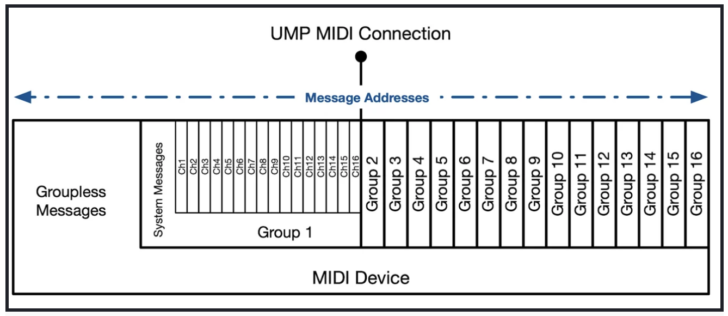
After three years of intensive prototyping and many virtual and face to face meetings, The Association of Musical Electronics Industry (AMEI) and The MIDI Association have published 4 significantly updated MIDI 2.0 core specifications and a brand new specification for a MIDI 2.0 SMF Clip File.
These are the result of many ‘man years ‘of volunteer work by members of AMEI and The MIDI Association and consist of over 350 pages of detailed specifications.
 These core specifications define the architectural foundations for MIDI 2.0 and define minimum requirements for devices to claim MIDI 2.0 compatibility and use the MIDI Association’s MIDI 2.0 logo.
These core specifications define the architectural foundations for MIDI 2.0 and define minimum requirements for devices to claim MIDI 2.0 compatibility and use the MIDI Association’s MIDI 2.0 logo.
AMEI and The MIDI Association have provided the specifications for free download, but you have to register first:
- Detailed information about MIDI 2.0 is on The MIDI Association website.
- All MIDI specifications are available for download.
With this updated MIDI 2.0 spec, plans are proceeding to open the MIDI Association Github which contains tools and source code under a permissive MIT license to all developers.
This follows public demos of MIDI 2.0 at the April 2023 NAMM show:
- Roland and Synthogy teamed up to demonstrate MIDI 2.0 High Resolution Velocity using an Apple computer and the publicly available version of Logic.
- There were working prototypes of both Microsoft and Linux MIDI 2.0 drivers.
- And Korg, Bome Box and Analog Devices were all showing prototype products that implemented MIDI 2.0.
For more detailed explanations about the updated MIDI spec, see the article “What Musicians and Artists need to know about MIDI 2.0,” on the MIDI Association website.

can anyone please explain like im 5 what this means for us as creators / synth users?
maybe not for many 5-year-olds, but here’s a go.
It’s a lot. MIDI has been based on numbers 0-127 for 40 years. Now the resolution can be much higher, so like more nuance in velocity when playing keyboard or drum controllers, finer pitch control without using bend, and very specific messages sent between devices. CC’s too, so a turn of a knob has more stops along the way to find a sweet spot or more fluid control while performing.
When connecting a knob controller from one manufacturer to a drum machine from another it will be possible for the devices to communicate and configure themselves to work together.
it goes on…
It’s fully backwards compatible, so you really don’t need to worry about any of it anyway. A 2.0 device can figure out the MIDI type of each device its connected to, and will act accordingly (via 1.0 or 2.0). I think the best way to say what’s happening for us with 2.0, besides higher resolution communication, is that communication goes back and forth, instead of a one-way street. So, it’s much more effective.
Hi Paul, if you really need a five years old explanation, stick to banging the triangle for now.
it means all the bit shaving done to alleviate latency on a slow serial bus can finally be tossed for the current fast interconnect on USB, BT or WIFI connected instruments. running it on the old 5DIN will increase latency a lot depending on traffic.
personally, I avoid all the MIDI computer crap.
Will it be possible to play two notes or more simultaneously? Can i layer two kicks without phasing issue?
I really want a theremin controller for analog monosynths. I’ve been told it’s difficult to nearly impossible in MIDI 1.0, but the backwards compatible handshake will make it really easy in MIDI 2.0.
MIDI 2.0 was announced in December 2019 and it’s taken this long to get…. here. So I’ll probably be waiting until about 2030.
This should be entirely possible with MIDI 1.0 using pitch bend messages for the “note” and plain old 127 steps of volume on the AMP stage of the synth. Could use nrpns for volume if having finer control is needed. Presuming the monosynth in question supports either/both. Otherwise, you’d have to use some sort of translation layer like Bome’s or something.
That is to say, I don’t think MIDI v1 is the roadblock to your theraminic control dreams – it’s the monosynth’s level of support for MIDI messages (1 or 2).
It’s taken long enough. Hopefully we won’t see the same long delay in seeing instruments, hardware and software, implementing it.
If it’s 2 way communication, do we still use MIDI IN, MIDI OUT, and MIDI THRU?
Or just USB 2.0?
Wow! Cool! Really looking forward to when we will se MIDI 2.0 products in 879 years.
lol
MIDI 1 changed everything about electronic music. Machines could work in tandem, computers could compliment hardware, and manufacturers co-operated and didn’t waste time on proprietary standards. MIDI 2 will open up visual interfaces for music gear, and will lead to a Golden Age of creative performances and new instruments. Standby.
eh, look at TRS MIDI if you think manufactures co-operate. three incompatible versions. oops!
From what I’ve seen, the real benefit will be higher bandwidth for everything that’s previously choked at show time. My new Mac’s M1 chip has totally banished problems with work load, so with 2.0 here, more serious multitimbrality and super-fluid MPE behaviors will become common. All that’s left is to see how quickly and *solidly* people adapt to it. Serious pros needed this more than casual home studio players did, but it’ll pay off.
When’s it out then? Where is midi 2.0 VST and controllers. Just talk which goes on forever
Thank god midi 1.0 came out quicker so synths actually had the thing. Dave smith RIP